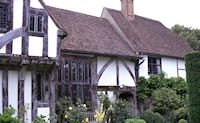Curator of Archaeology and the Historic Environment for the Museum of Liverpool, National Museums Liverpool. Email: Liz.Stewart@liverpoolmuseums.org.uk

Medieval and Tudor buildings have been altered in order to display them to the public since the late 19th century. Using a sample of 112 houses, all those in England originally constructed between 1400 and 1600 that are currently open to the public, this research analysed the impact of reconstruction work on historic houses. Analysis has revealed the types of changes made to historic houses through the late nineteenth and twentieth centuries. Six case studies will be considered to exemplify the works identified at different periods.

The philosophies behind works undertaken on individual buildings are considered in the context of contemporary ideas of the conservation movement, and tensions between the broad conservation philosophies of the time and the work undertaken on individual buildings are investigated. This recent history of buildings is an important element in the planning and management of them into the future, and this research enhances understanding of this history.
Go to article Table of Contents.
© Internet Archaeology/Author(s)
University of York legal statements | Terms and Conditions
| File last updated: Thur Feb 25 2011